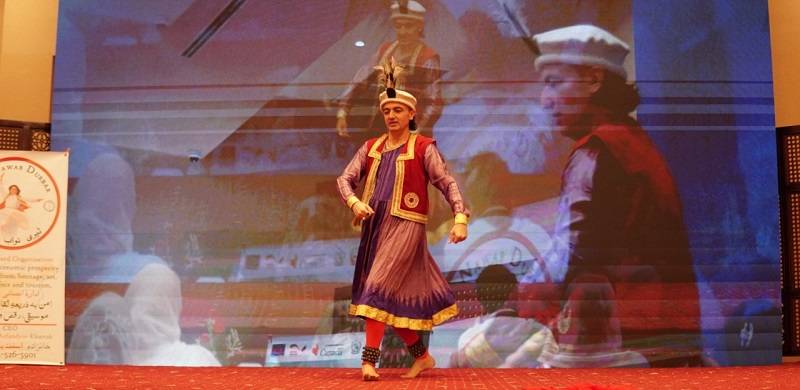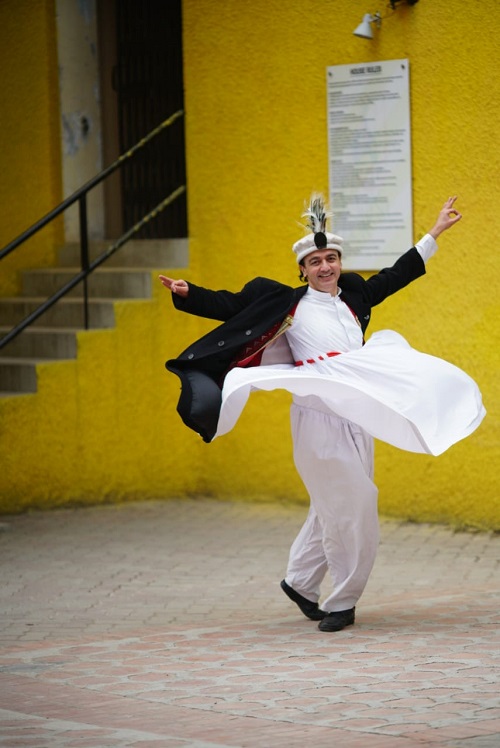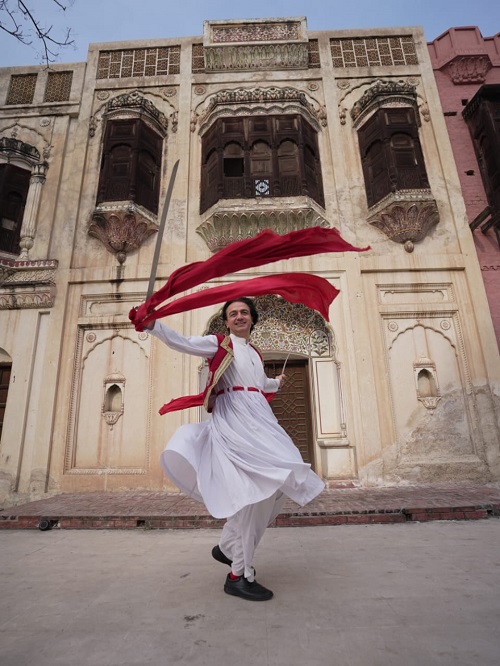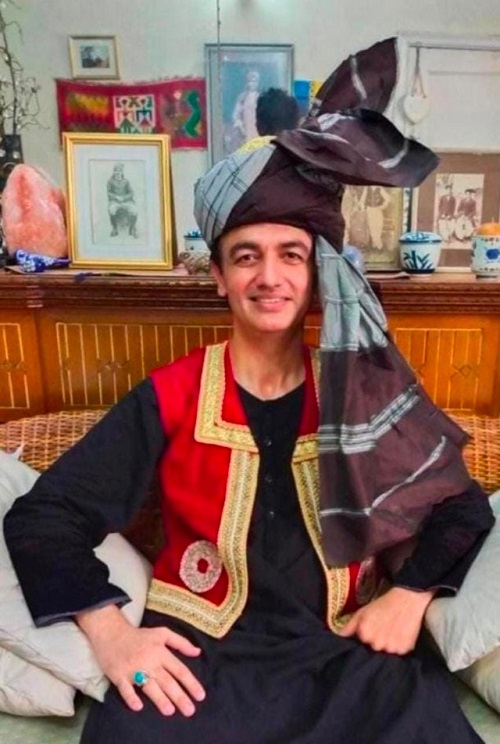
My driver was slow as usual, and I had a few errands to run before meeting the arty and aristocratic Kathak and fusion dancer. It was a pleasure to have come across someone who is as punctual as I. However, I got delayed by few minutes and as soon as I stepped on the elevator, my phone rang. “I am here Ms. Madiha, where are you?" As I reached our chat with chai place and looked up, there he was, almost sublime in sky-blue, khaddar kurta pajama (Aligarh kaath) blocking the sunlight which created a halo around his being. Tall, lean with exotic features and graceful movements, Asfandyar Khattak extended a handshake, a little unsure if I would take it, apprehensive of my social ethics, and said “Aadaab.” Who would not like to meet such a refined male, who has aesthetics of a Kathak dancer merged with the pride of being the 12th-generation descendent of Khushhal Khan Khattak.
I quickly settled down with my phone, notebook and pen. He had brought his friend and mentor along, who is a professor and researcher on the evolution of dance at the Area Study Centre for history at Peshawar University.
"Yeh menu bhi pooray pooray thesis hootay hain,” Asfandyar remarked when I asked him to pick up some refreshments of his choice.
 Before I knew it, we hit it off as if we've known each other for some time. With formal introductions Asfandyar started flowing au naturel about his education, both academic and dance. He studied at Beaconhouse School, Islamabad till A-levels. He completed his four-year BBA followed by an MBA from COMSATS University, Islamabad. Though that was not important for me to recognise his capabilities as a refined dancer, nevertheless it did say volumes about his inquisitive nature. His research on each and every thing coming along his way is evidence of his in-depth knowledge on matters we usually sweep under the rug.
Before I knew it, we hit it off as if we've known each other for some time. With formal introductions Asfandyar started flowing au naturel about his education, both academic and dance. He studied at Beaconhouse School, Islamabad till A-levels. He completed his four-year BBA followed by an MBA from COMSATS University, Islamabad. Though that was not important for me to recognise his capabilities as a refined dancer, nevertheless it did say volumes about his inquisitive nature. His research on each and every thing coming along his way is evidence of his in-depth knowledge on matters we usually sweep under the rug.
Asfandyar came across as a sensitive yet rational person. He easily glides through emotions and pragmatism.
He has been associated with the development sector since 2001, and has worked in several foreign-funded projects, such as those with USAID, USIP, UNICEF, the British Council, Oxfam, TAF and DAI. His work is mostly on human rights advocacy, gender empowerment, ending violence against women and children’s rights. This aspect of his journey has brought him more awareness of the social impediments to empowerment. Before I talked to Asfandyar, I was quite convinced that it is the feminist movement which suffers the most. “You know, when we (dancers) are to perform at public venues, we still have to write down 'Movement and Mime' in the performance section, instead of unencrypted 'Dance'(the genre) in the application form!”
The pain and plight with which it was communicated to me, made me regretful of our undercurrent of fundamentalism as a society trying to survive in this age of self assertion. Asfandyar reminded me of a legal directive, which states:
"No such obscenity, such as dance, is allowed.”
Obscenity? Really?
I was speechless.
Asfandyar reminded me of his vulnerability as a male dancer. It's impossible to make people realise that the dances Kathak and Khattak are our tradition and deeply rooted in our culture. His research on dance and local culture is deep as an ocean. One is not only talking to a kathak performer, but a scholar too, when interacting with Asfandyar.
Asfandyar started learning the Indian classical dance form of Kathak dance in 2001. In 2007, he became a student of the living legend Indu Mitha – nonagenarian guru/ustaad of South Indian classical dance, Bharat Natyam.
Being of the Khattak tribe, Asfandyar performs the Khattak-waal Ataanr. He also performs Afghan dances such as Logari, Kataghani (Uzbek) and Afshari (Dari – Persian).
Asfandyar has performed at platforms including the Pakistan National Council of the Arts - PNCA, Lok Virsa, Karachi Arts Council, Lahore Arts Council and Rafi Peer Theatre Sufi Festivals. For his dance fusion of Khattak and Kathak, Asfandyar is equally popular in Afghanistan, where he has performed for several television programs at Kabul by Lemar TV and Shamshad TV. He has danced in all major cities of Pakistan, Afghanistan and Malaysia. Asfandyar has been interviewed for his art and advocacy through dance, by local, national and international media. Even during COVID-19, he struggled to educate dance students through Zoom classes.
Watching him perform at PNCA Islamabad several times, experiencing his choreography at Serena Hotel Islamabad and witnessing his intricate footwork and precise rhythmic patterns that the dancer articulates by controlling about 100 ankle bells - the visual aspect is enchanting.
In the Pashtun tradition, the Khattak dance is a traditional war dance, and Kathak here becomes ‘taboo’ for for a performer of Pashtun descent. Almost all artists go through cultural bashing, and so did Asfandyar, never losing his ground. His most enthralling moment, he says, was when he wore ghungroo (the musical anklets) and danced on stage where his father was experiencing and watching him for the very first time as a Kathak dancer. His father was proud of this trout who swam by his own flow.

He is the first properly trained Pashtun dancer who performs as a profession. Moreover, he is the first Pasthun dancer to dance not only in his own country, but also in his own province KP – among his own Pashtun people, regardless of the taboos. He is the pioneer of the dance fusion of Khattak and Kathak.
Asfandyar says: “My grandfather Khushal Khan Khattak fought for the rights of Pashtuns in the 17th century. He stood up against the atrocities of the Mughal Emperor, Aurangzeb. Khushal Khan used his poetry and sword to fight for the honour of Afghans. I, Khushal Khan's great grandson – am carrying forward his message in the 21st century using dance and ghungroos in my fight against hatred and injustice. I, the whirling Pashtun, want to dance for peace and love. In my own capacity, I am trying to reclaim my culture - a culture which is full of music and dance."
Khushal Khan Khattak said:
De Afghan po naang may wotarrala toora,
Nangyalaey de zamaanay Khushal Khattak yaN.
(I bound on to the sword for the pride of the Afghan name,
I am Khushal Khattak, the proud man of this day)
Discussing the new bill on the rights of transgender individuals, he has strong views about how to ‘live and let live’ without being conspicuous. When I asked him about marriage and love, Asfandyar was sublime on the subject. Of course, his first love is dance, he points out – and whoever has the capacity to appreciate his first love would be his partner in life. Quite practical, I would say.
Asfandyar has been inspiration for other artists – musicians, singers and actors have been reaching out to him through social media. This has compelled him to make the best use of internet and technology in promotion of his art. He plays the role of a teacher as much as a performer or breaker of taboos.
I quickly settled down with my phone, notebook and pen. He had brought his friend and mentor along, who is a professor and researcher on the evolution of dance at the Area Study Centre for history at Peshawar University.
"Yeh menu bhi pooray pooray thesis hootay hain,” Asfandyar remarked when I asked him to pick up some refreshments of his choice.
 Before I knew it, we hit it off as if we've known each other for some time. With formal introductions Asfandyar started flowing au naturel about his education, both academic and dance. He studied at Beaconhouse School, Islamabad till A-levels. He completed his four-year BBA followed by an MBA from COMSATS University, Islamabad. Though that was not important for me to recognise his capabilities as a refined dancer, nevertheless it did say volumes about his inquisitive nature. His research on each and every thing coming along his way is evidence of his in-depth knowledge on matters we usually sweep under the rug.
Before I knew it, we hit it off as if we've known each other for some time. With formal introductions Asfandyar started flowing au naturel about his education, both academic and dance. He studied at Beaconhouse School, Islamabad till A-levels. He completed his four-year BBA followed by an MBA from COMSATS University, Islamabad. Though that was not important for me to recognise his capabilities as a refined dancer, nevertheless it did say volumes about his inquisitive nature. His research on each and every thing coming along his way is evidence of his in-depth knowledge on matters we usually sweep under the rug.Asfandyar came across as a sensitive yet rational person. He easily glides through emotions and pragmatism.
He has been associated with the development sector since 2001, and has worked in several foreign-funded projects, such as those with USAID, USIP, UNICEF, the British Council, Oxfam, TAF and DAI. His work is mostly on human rights advocacy, gender empowerment, ending violence against women and children’s rights. This aspect of his journey has brought him more awareness of the social impediments to empowerment. Before I talked to Asfandyar, I was quite convinced that it is the feminist movement which suffers the most. “You know, when we (dancers) are to perform at public venues, we still have to write down 'Movement and Mime' in the performance section, instead of unencrypted 'Dance'(the genre) in the application form!”
The pain and plight with which it was communicated to me, made me regretful of our undercurrent of fundamentalism as a society trying to survive in this age of self assertion. Asfandyar reminded me of a legal directive, which states:
"No such obscenity, such as dance, is allowed.”
Obscenity? Really?
I was speechless.
Asfandyar reminded me of his vulnerability as a male dancer. It's impossible to make people realise that the dances Kathak and Khattak are our tradition and deeply rooted in our culture. His research on dance and local culture is deep as an ocean. One is not only talking to a kathak performer, but a scholar too, when interacting with Asfandyar.
Asfandyar started learning the Indian classical dance form of Kathak dance in 2001. In 2007, he became a student of the living legend Indu Mitha – nonagenarian guru/ustaad of South Indian classical dance, Bharat Natyam.
Being of the Khattak tribe, Asfandyar performs the Khattak-waal Ataanr. He also performs Afghan dances such as Logari, Kataghani (Uzbek) and Afshari (Dari – Persian).

Asfandyar has performed at platforms including the Pakistan National Council of the Arts - PNCA, Lok Virsa, Karachi Arts Council, Lahore Arts Council and Rafi Peer Theatre Sufi Festivals. For his dance fusion of Khattak and Kathak, Asfandyar is equally popular in Afghanistan, where he has performed for several television programs at Kabul by Lemar TV and Shamshad TV. He has danced in all major cities of Pakistan, Afghanistan and Malaysia. Asfandyar has been interviewed for his art and advocacy through dance, by local, national and international media. Even during COVID-19, he struggled to educate dance students through Zoom classes.
Watching him perform at PNCA Islamabad several times, experiencing his choreography at Serena Hotel Islamabad and witnessing his intricate footwork and precise rhythmic patterns that the dancer articulates by controlling about 100 ankle bells - the visual aspect is enchanting.
In the Pashtun tradition, the Khattak dance is a traditional war dance, and Kathak here becomes ‘taboo’ for for a performer of Pashtun descent. Almost all artists go through cultural bashing, and so did Asfandyar, never losing his ground. His most enthralling moment, he says, was when he wore ghungroo (the musical anklets) and danced on stage where his father was experiencing and watching him for the very first time as a Kathak dancer. His father was proud of this trout who swam by his own flow.

He is the first properly trained Pashtun dancer who performs as a profession. Moreover, he is the first Pasthun dancer to dance not only in his own country, but also in his own province KP – among his own Pashtun people, regardless of the taboos. He is the pioneer of the dance fusion of Khattak and Kathak.
Asfandyar says: “My grandfather Khushal Khan Khattak fought for the rights of Pashtuns in the 17th century. He stood up against the atrocities of the Mughal Emperor, Aurangzeb. Khushal Khan used his poetry and sword to fight for the honour of Afghans. I, Khushal Khan's great grandson – am carrying forward his message in the 21st century using dance and ghungroos in my fight against hatred and injustice. I, the whirling Pashtun, want to dance for peace and love. In my own capacity, I am trying to reclaim my culture - a culture which is full of music and dance."
Khushal Khan Khattak said:
De Afghan po naang may wotarrala toora,
Nangyalaey de zamaanay Khushal Khattak yaN.
(I bound on to the sword for the pride of the Afghan name,
I am Khushal Khattak, the proud man of this day)
Discussing the new bill on the rights of transgender individuals, he has strong views about how to ‘live and let live’ without being conspicuous. When I asked him about marriage and love, Asfandyar was sublime on the subject. Of course, his first love is dance, he points out – and whoever has the capacity to appreciate his first love would be his partner in life. Quite practical, I would say.
Asfandyar has been inspiration for other artists – musicians, singers and actors have been reaching out to him through social media. This has compelled him to make the best use of internet and technology in promotion of his art. He plays the role of a teacher as much as a performer or breaker of taboos.

